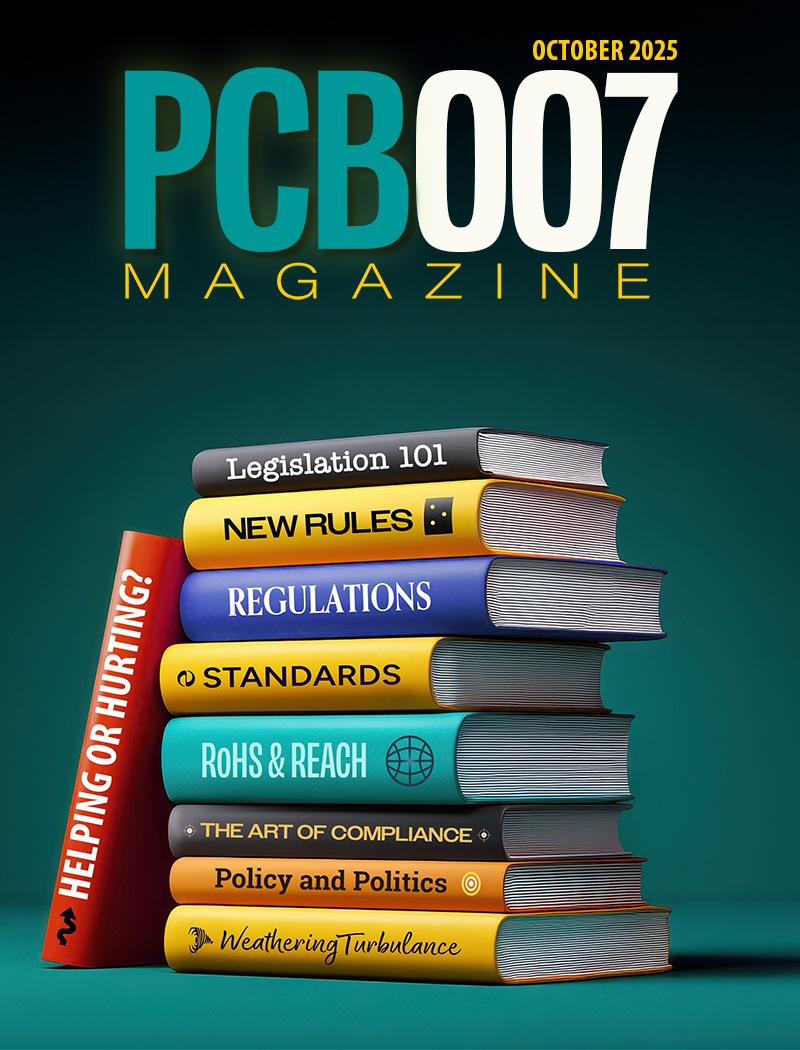-

-
News
News Highlights
- Books
Featured Books
- pcb007 Magazine
Latest Issues
Current Issue
The Legislative Outlook: Helping or Hurting?
This month, we examine the rules and laws shaping the current global business landscape and how these factors may open some doors but may also complicate business operations, making profitability more challenging.

Advancing the Advanced Materials Discussion
Moore’s Law is no more, and the advanced material solutions to grapple with this reality are surprising, stunning, and perhaps a bit daunting. Buckle up for a dive into advanced materials and a glimpse into the next chapters of electronics manufacturing.

Inventing the Future With SEL
Two years after launching its state-of-the-art PCB facility, SEL shares lessons in vision, execution, and innovation, plus insights from industry icons and technology leaders shaping the future of PCB fabrication.
- Articles
- Columns
- Links
- Media kit
||| MENU - pcb007 Magazine
Estimated reading time: 3 minutes
All About Flex: Non-Copper Flexible Circuit Applications
While pure copper is the most common choice for flexible circuit fabrication, there are times a different metal is more suitable for an application. Copper is well known for its excellent electrical and thermal conductivity, but there are applications where the best thermal or electrical conductivity can be a disadvantage.
Flexible heater circuits often use metals other than pure copper. Higher resistance copper alloys are popular substitutes for copper, which are used as the metal heater element. The main reason for these pure copper substitutes is because copper resistance is often too low to draw enough of the power required to create the desired heat profile in a fixed voltage application. Customized polyimide heaters combine alternative metals and unique trace/space patterns to create design options for a wide array of temperature outputs. Finite Element Analysis (FEA) software can be used to accurately predict thermal output in a solid engineering model with considerations for heat sinks and air flows. Actual heater fabrication will involve differences in processing requirements, most significantly in the etching chemistries needed.
Thermal conductivity can be an important characteristic in certain applications. Wikipedia defines thermal conductivity as “the property of a material to conduct heat, evaluated primarily in terms of Fourier's Law for heat conduction.” Lower thermal conductivity is often desirable in applications where extreme temperature variations occur. There are many applications where a product needs to withstand large changes in temperature. Any product that is used outdoors can experience temperatures in the summer of more than 100°F in warm climates and temperature down to –40°F in cold climates. While these temperatures may seem extreme, they are not significant enough to require a material with lower thermal conductivity. But there are some applications where temperature differences far exceed typical ambient extremes.
Cryogenics
Cryogenics is the area of physics that studies the impact of very low temperatures on materials and systems. In these applications, cold has an entirely different meaning as temperatures of –238°F and lower are required. In the case of a cryogenic product, the outside temperature is ambient, but the chamber can be maintained as low as –500°F. At these extremely low temperatures, most metals become superconductors and they conduct electricity with near zero resistance. This creates a desirable feature as electronic and power systems become extremely efficient as very little energy is expended. High-performance computing is often done at cryogenic temperatures with products that include super computers, communication equipment, and specialty test equipment.
Satellites
Satellites are another application where heat transfer needs to be limited, as the outside of a satellite can see temperatures as low as –150°F and as high as 550°F.
As with cryogenic products, lower thermal conductivity is desired to minimize heat transfer from higher temperature regions into super cooled chambers. In the case of the satellite the outside surface temperature may exceed 500°F. Lower thermal conductivity can retard the rate heat is transferred into the body of a satellite.
Copper-nickel alloys (Cu-Ni) have properties that make them good choices for these extreme temperature applications as well as for heater circuits. Cu-Ni 715 is 70% copper and has thermal conductivity that is 1/13th of pure copper and is 1/20th as electrically conductive. While these materials have less elongation and lower electrical conductivity, Cu-Ni alloys can still be used in many interconnect applications that require some flexibility. Another copper nickel alloy is Constantan. This material is a copper and nickel alloy consisting of 55% copper and 45% nickel. Constantan is a desirable alloy in certain applications as its resistance remains stable over a wide range of temperatures. A third alternative metal alloy is Inconel, which has a variety of compositions, primarily consisting of nickel, chrome and iron. Inconel has a considerably higher resistance vs. Cu-Ni 715 and Constantan, and is often used in extreme environments of pressure and heat. The higher resistance also helps offer options for a wider range of temperatures with flexible heater elements.
As alternative metals are adopted in flex-circuit applications, alternative surface treatments and wire attachment methods may be required—especially as materials deviate farther away from pure copper properties. Many typical surface finishes can be used with Cu-Ni flexible circuits and the parts are often fabricated using common PCB processes and chemistries.
Dave Becker is vice president of sales and marketing at All Flex Flexible Circuits LLC.
More Columns from All About Flex
All About Flex: Terms and ConditionsAll About Flex: ISO 9001 Basics
All About Flex: FAQs on UL Listings for Flexible Circuits
All About Flex: Avoiding Trace Fracturing in a Flexible Circuit
Polyimide vs. Silicone for Flexible Heaters
All About Flex: Copper Thickness Requirements for Flex Circuits
All About Flex: Copper Grain Direction
All About Flex: Options for Purchasing Flexible Heaters


